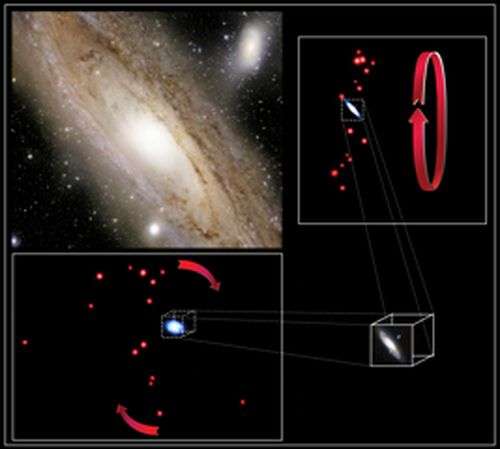The top left hand image is a truecolour photograph (taken with the Canada-France-Hawaii Telescope) of the Andromeda galaxy, the closest giant galaxy to our own, and in many ways our Milky Way’s twin sister. Also visible in this photograph are two of its satellites (these are much smaller galaxies, containing up to about a billion stars). Our study has measured the distances and velocities of 27 other such dwarf galaxies : their three-dimensional positions are shown with red spheres in the other panels. The top right hand panel depicts how these appear to us as viewed from Earth, while the bottom left panel shows the positions of the satellites as they would be seen from the side. This immense grouping is more than a million light years across and rotates in the sense shown by the arrows.
(Phys.org)—A newly discovered form of circle dancing is perplexing astronomers; not due to its complex choreography, but because it's unclear why the dancers – dwarf galaxies – are dancing in a ring around the much larger Andromeda Galaxy.
The international group of astronomers who discovered the curious cosmic choreography, including Professor Geraint Lewis from the University of Sydney's School of Physics, and Australian astronomers Anthony Conn, a PhD student at Macquarie University, and Dr Dougal Mackey from the Australian National University, are surprised at the circle around Andromeda that the small orbiting galaxies have formed.
The finding, published in Nature on January 2, 2013, presents a challenge to our ideas of how all galaxies form and evolve.
The surprising research result reveals that around half of Andromeda's 30-odd known dwarf galaxy satellites are orbiting the larger Andromeda Galaxy – the closest giant cosmic neighbour to our own galaxy, the Milky Way.
Credit: University of Sydney
"Astronomers have been observing Andromeda since Persian astronomers first noted it over a thousand years ago, but it is only in the past decade that we have truly studied it in exquisite detail with the Pan-Andromeda Archaeological Survey," said Professor Geraint Lewis, one of the lead authors on the Nature paper.
"The Pan-Andromeda Archaeological Survey – cutely called PAndAS – is a large project that ran between 2008 and 2011, using the Canada-France-Hawaii Telescope situated on the Mauna Kea volcano on the Big Island of Hawaii. Now that we're examining the data it collected, it is providing our first panoramic view of our closest large companion in the cosmos," explained Professor Lewis.
"When we looked at the dwarf galaxies surrounding Andromeda, we expected to find them buzzing around randomly, like angry bees around a hive.
"Instead, we've found that half of Andromeda's satellites are orbiting together in an immense plane, which is more than a million light years in diameter but only 30 000 light years thick. These dwarf galaxies have formed a ring around Andromeda."
"This was completely unexpected – the chance of this happening randomly is next to nothing. It really is just weird," said Professor Lewis.
Large galaxies, like Andromeda and our own Milky Way, have long been known to be orbited by an entourage of smaller galaxies. These small galaxies, which are individually anywhere from ten to at least hundreds of thousands of times fainter than their bright hosts, were thought to trace a path around the big galaxy that was independent of every other dwarf galaxy.
For several decades, astronomers have used computer models to predict how dwarf galaxies should orbit large galaxies, and every time they found that dwarfs should be scattered randomly over the sky. Never, in these synthetic universes, did they see dwarfs arranged in a plane like that observed around Andromeda.
"Now that we've found that the majority of these dwarf galaxies orbit in a disc around the giant galaxy Andromeda, it looks like there must be something about how these galaxies formed or subsequently evolved that has led them to trace out this peculiar coherent structure," said Professor Lewis.
"Dwarf galaxies are the most numerous galaxy type in the universe, so understanding why and how they form this disc around the giant galaxy is expected to shed new light on the formation of galaxies of all masses."
PhD student, Anthony Conn, whose research proved key to this study said, "It is very exciting for my work to reveal such a strange structure. It has left us scratching our heads as to what it means."
There have been similar claims of an extensive plane of dwarf galaxies about our own Milky Way Galaxy, with some claiming that the existence of such strange structures points to a failing in our understanding of the fundamental nature of the Universe.
"We don't yet know where this is pointing us, but it surely is very exciting," said Dr Rodrigo Ibata, from the Observatoire astronomique de Strasbourg, in France, and lead author on the report.
Journal information: Nature
Provided by University of Sydney























